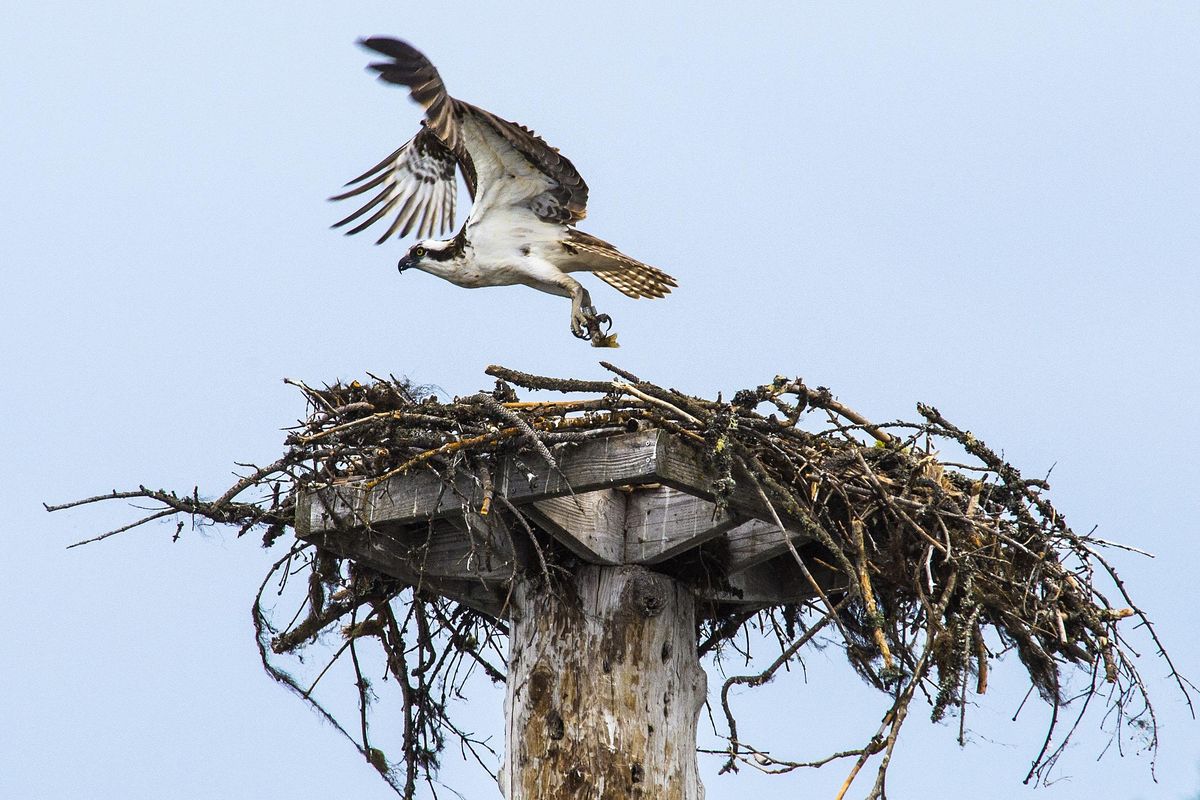The view from on high: 45 years of studying ospreys in the Pacific Northwest

After 45 years of studying ospreys, Wayne Melquist does a pretty good imitation of the bird’s distinctive call.
The retired biologist let out a high-pitched chirp, followed by a keening cry as the pontoon boat he was riding in approached a nest on a piling in Lake Coeur d’Alene’s Cougar Bay on Saturday morning. An adult female answered him.
She circled overhead as Melquist scrambled up a 24-foot extension ladder to the nest, where he found two chicks. Each youngster was promptly tagged with an aluminum band on its leg, identifiers that will help scientists track trends in the region’s osprey population.
“You can see the red eyes,” said Melquist, gently handling a downy chick. “When it’s an adult, the eyes will turn yellow.”
The chicks’ feathers looked a bit like Harris Tweed, with a light and dark pattern that helps camouflage them in the nest. When the birds reach adulthood, they’ll be dark brown, with a white head and chest and a black, banditlike eye band.
At about 5 weeks old, the chicks already had impressive talons. Soon, they’ll be fledged and learning how to pluck fish out of the water.
Melquist has banded Lake Coeur d’Alene’s ospreys for more than four decades. He started as a graduate student at the University of Idaho in 1972 and continued the work during a long career with the Idaho Department of Fish and Game. He’s retired now but isn’t ready to surrender his federal bird-banding license.
There’s still much to learn about the majestic birds, which raise their young on the region’s lakes and rivers but winter in Mexico and Central America, said Melquist, 69.
Each band is marked with an identification code and a phone number for people to call when they find a dead bird. The information goes into a national registry.
Most wildlife research is done on a time frame of three to five years. So, the longevity of Melquist’s work is fairly unusual, said Bruce Peterjohn, chief of the U.S. Geological Survey’s Bird Banding Laboratory at the Patuxent Wildlife Research Center in Maryland.
When Melquist first started banding ospreys, DDT had recently been banned. The pesticide altered birds’ calcium metabolism, resulting in thin eggshells that easily broke.
“Osprey and bald eagles were sort of the poster child for the effect of DDT on birds,” Peterjohn said. “The numbers were low and declining.”
Now, ospreys are common in the Idaho Panhandle, which has about 200 nesting pairs.
Melquist’s work “provides a perspective that might otherwise be lost,” Peterjohn said. “People might see a lot of osprey and think they’ve always been abundant.”
The long-running study also sheds light on nesting patterns, migration routes, wintering areas and interchange with other Western osprey populations.
Cougar Bay, for instance, once had 13 osprey nests. On Saturday morning, Melquist counted six nests on pilings. Two of the nests he approached were empty. The eggs didn’t hatch or the chicks had died.
Cougar Bay used to be covered with floating logs that supplied Coeur d’Alene’s waterfront sawmills. The logs provided good fish habitat for foraging ospreys.
Removal of the logs after the mill closures probably made Cougar Bay less productive for ospreys, Melquist said. In recent years, cormorants also have established colonies in the bay. Their presence may have made the area less appealing to ospreys, he said.
Human actions also continue to affect osprey populations. Other countries still allow the use of DDT, resulting in possible exposure to local ospreys in their wintering range, Melquist said. Locally, fishermen can cause problems for ospreys if their boats approach too close to nest sites during the critical egg incubation period. If the adult ospreys are flushed off the nests for extended periods, the eggs won’t survive, he said.
This summer, Melquist helped relocate four osprey chicks to new nests after their parents were killed. One of the adult birds was hit by a logging truck, and another pair died in a freak midair collision. Melquist found nests for the orphaned birds where the chicks were about the same age. The transplants seem to be doing well with their foster families, he said.
Gusty winds blew across the lake Saturday morning, which made the ascent to the nests for banding more challenging. Melquist had recruited a friend, Brenda Garcia, to take him around to the nests in her pontoon boat.
Garcia let the boat drift to each nest site. Two volunteer crew members – Teri Farr and Mary Sanderson – grabbed hold of the piling, trying to keep the boat from rocking in the choppy waves as Melquist climbed up the ladder. He banded five chicks at two nests with no mishaps.
“I usually can feel it when the ladder starts to go sideways,” he said.
Melquist paused to watch an adult male carrying a fish to a nest, swooping and regaining altitude. The undulating flight is part of courtship for males, he said. The behavior continues even after nesting.
“It cements their bond,” he said of osprey pairs.
As Melquist climbed down the ladder from one of the nests, an adult female made a beeline back to her chicks.
“Is she banded?” Melquist wondered.
Ospreys can live for about 10 to 15 years, so some of this year’s chicks could be great-grandchildren of the first ospreys Melquist banded.
One of the Cougar Bay nests was on a tall piling, too high to reach with the extension ladder Melquist brought along on Saturday.
“Next time,” he said, “I’ll bring my 30-foot ladder.”